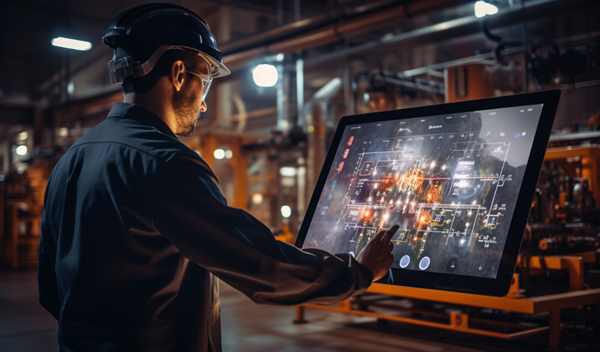4
Jul
Exploring the Benefits and Applications of Touch Screen Monitors

In today’s digital age, touch screen monitors have become ubiquitous across various industries. From retail and hospitality to education and healthcare, these interactive displays are revolutionizing the way we interact with technology. In this article, we’ll delve into the benefits, applications, and future trends of touch screen monitors, highlighting why they are an essential tool in modern business and everyday life.
What is a Touch Screen Monitor?
A touch screen monitor is a display device that allows users to interact directly with what is shown on the screen by touching it with a finger or a stylus. This intuitive interface eliminates the need for traditional input devices such as keyboards and mice, offering a more engaging and efficient user experience.
Key Benefits of Touch Screen Monitors
1. Enhanced User Experience
One of the primary advantages of touch screen monitors is their ability to provide an enhanced user experience. The intuitive interface makes navigation straightforward, reducing the learning curve for new users. This ease of use is particularly beneficial in retail and customer service environments, where quick and efficient interactions are crucial.
2. Space-Saving Design
Touch screen monitors combine display and input functions into a single device, eliminating the need for additional peripherals. This space-saving design is ideal for environments with limited space, such as point-of-sale (POS) counters, kiosks, and small office setups.
3. Increased Productivity
The efficiency of touch screen technology can significantly boost productivity. Tasks that require multiple steps with a keyboard and mouse can often be accomplished with a single touch or swipe. This speed and efficiency are particularly valuable in fast-paced industries like healthcare and retail, where every second counts.
4. Versatile Applications
Touch screen monitors are highly versatile and can be used in a wide range of applications. From interactive digital signage and self-service kiosks to educational tools and professional presentations, these monitors can adapt to various needs and environments.
5. Durability and Reliability
Modern touch screen monitors are built to withstand heavy use and are designed with durability in mind. Many models feature robust, scratch-resistant surfaces and are engineered to operate reliably in demanding conditions, making them suitable for high-traffic areas and industrial environments.
Applications of Touch Screen Monitors
1. Retail and Hospitality
In the retail and hospitality sectors, touch screen monitors are used for POS systems, self-service kiosks, and interactive displays. They enhance the customer experience by providing quick and easy access to product information, enabling seamless transactions, and offering personalized recommendations.
2. Education
Touch screen monitors are transforming the classroom by providing interactive learning tools. Educators can use these monitors to create engaging lessons, facilitate collaborative activities, and access a wealth of digital resources. Students benefit from hands-on learning experiences that can improve comprehension and retention.
3. Healthcare
In healthcare settings, touch screen monitors streamline patient check-ins, facilitate accurate data entry, and provide access to electronic medical records. These monitors also support telemedicine applications, allowing healthcare professionals to conduct remote consultations and access patient information securely.
4. Corporate and Professional Use
Touch screen monitors are valuable tools in corporate environments, enhancing presentations, meetings, and collaborative projects. Interactive whiteboards and large-format touch displays enable teams to brainstorm, annotate, and share ideas in real-time, improving communication and productivity.
5. Industrial and Manufacturing
In industrial and manufacturing environments, touch screen monitors are used for machine control, monitoring, and data entry. Their rugged design ensures reliable performance in harsh conditions, and their intuitive interface simplifies complex processes, reducing the risk of errors.
Future Trends in Touch Screen Technology
As technology continues to evolve, touch screen monitors are expected to incorporate advanced features that further enhance their functionality and user experience. Some emerging trends include:
1. Multi-Touch and Gesture Recognition
Future touch screen monitors will support more advanced multi-touch and gesture recognition capabilities, allowing for more sophisticated interactions and greater flexibility in how users engage with the display.
2. Higher Resolution and Display Quality
Advancements in display technology will lead to higher resolution screens with better color accuracy and brightness. This improvement will be particularly beneficial for applications requiring detailed visuals, such as graphic design and medical imaging.
3. Integration with Artificial Intelligence (AI)
AI integration will enable touch screen monitors to offer more personalized and adaptive user experiences. For example, AI algorithms can analyze user behavior to provide tailored recommendations and automate routine tasks.
4. Enhanced Connectivity
Improved connectivity options, such as 5G and Wi-Fi 6, will allow touch screen monitors to seamlessly integrate with other devices and networks. This connectivity will support real-time data sharing and collaboration, further enhancing their utility in various applications.
5. Augmented Reality (AR) and Virtual Reality (VR) Integration
The integration of AR and VR technologies will open up new possibilities for touch screen monitors. Users will be able to interact with virtual objects and environments, creating immersive experiences for training, education, and entertainment.
Conclusion
Touch screen monitors are a powerful tool that offers numerous benefits and versatile applications across various industries. Their ability to enhance user experience, increase productivity, and adapt to different environments makes them an essential technology for modern businesses and individuals. As touch screen technology continues to advance, we can expect even more innovative features and applications that will further revolutionize how we interact with digital content.
By understanding the benefits and potential of touch screen monitors, businesses and individuals can make informed decisions about incorporating this technology into their operations and daily lives. Embrace the future of interactive displays and unlock new possibilities with touch screen monitors.
